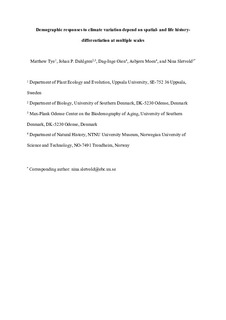| dc.contributor.author | Tye, Matthew | |
| dc.contributor.author | Dahlgren, Johan P. | |
| dc.contributor.author | Øien, Dag-Inge | |
| dc.contributor.author | Moen, Asbjørn | |
| dc.contributor.author | Sletvold, Nina | |
| dc.date.accessioned | 2019-02-08T13:26:04Z | |
| dc.date.available | 2019-02-08T13:26:04Z | |
| dc.date.created | 2018-10-26T13:16:13Z | |
| dc.date.issued | 2018 | |
| dc.identifier.citation | Biological Conservation. 2018, 228 62-69. | nb_NO |
| dc.identifier.issn | 0006-3207 | |
| dc.identifier.uri | http://hdl.handle.net/11250/2584617 | |
| dc.description.abstract | Long-term demographic data are needed for detailed viability analyses of populations threatened by climate change, but the infeasibility of obtaining such data makes it urgent to assess whether demographic responses to climatic variation can be generalized across populations and species. We used 32 years of demographic data on four species of closely related orchids (genera Dactylorhiza and Gymnadenia), replicated in a coastal and an inland region in central Norway, to test how demographic responses to climate varied among geographical regions and species. We fit generalized linear mixed models (GLMMs) to study climate effects on vital rates and included GLMMs as components in matrix models to examine climate effects on population dynamics. We found that, overall, vital rates and population growth rates of the eight populations responded independently to variation in both temperature and rainfall. Only probability of flowering showed expected regional differentiation in response to climate, despite notable regional climatic differences. Other vital rate – climate relationships were structured by species or a combination of both region and species. The weak clustering of demographic responses to climate variation by species and region demonstrates that effects of climatic variation can strongly depend on variation in local habitat and life history, even among closely related populations occupying similar niches. This highlights the difficulty in transferring data from closely related and/or located populations for viability analyses and for models predicting range shifts, and a general need to account for among-population variation in demographic responses to develop successful conservation and management plans. | nb_NO |
| dc.language.iso | eng | nb_NO |
| dc.publisher | Elsevier | nb_NO |
| dc.rights | Attribution-NonCommercial-NoDerivatives 4.0 Internasjonal | * |
| dc.rights.uri | http://creativecommons.org/licenses/by-nc-nd/4.0/deed.no | * |
| dc.title | Demographic responses to climate variation depend on spatial- and life history-differentiation at multiple scales | nb_NO |
| dc.title.alternative | Demographic responses to climate variation depend on spatial- and life history-differentiation at multiple scales | nb_NO |
| dc.type | Journal article | nb_NO |
| dc.type | Peer reviewed | nb_NO |
| dc.description.version | acceptedVersion | nb_NO |
| dc.source.pagenumber | 62-69 | nb_NO |
| dc.source.volume | 228 | nb_NO |
| dc.source.journal | Biological Conservation | nb_NO |
| dc.identifier.doi | 10.1016/j.biocon.2018.10.005 | |
| dc.identifier.cristin | 1623877 | |
| dc.description.localcode | © 2018. This is the authors’ accepted and refereed manuscript to the article. Locked until 13.10.2018 due to copyright restrictions. This manuscript version is made available under the CC-BY-NC-ND 4.0 license http://creativecommons.org/licenses/by-nc-nd/4.0/ | nb_NO |
| cristin.unitcode | 194,31,10,0 | |
| cristin.unitname | Institutt for naturhistorie | |
| cristin.ispublished | true | |
| cristin.fulltext | postprint | |
| cristin.qualitycode | 1 | |

